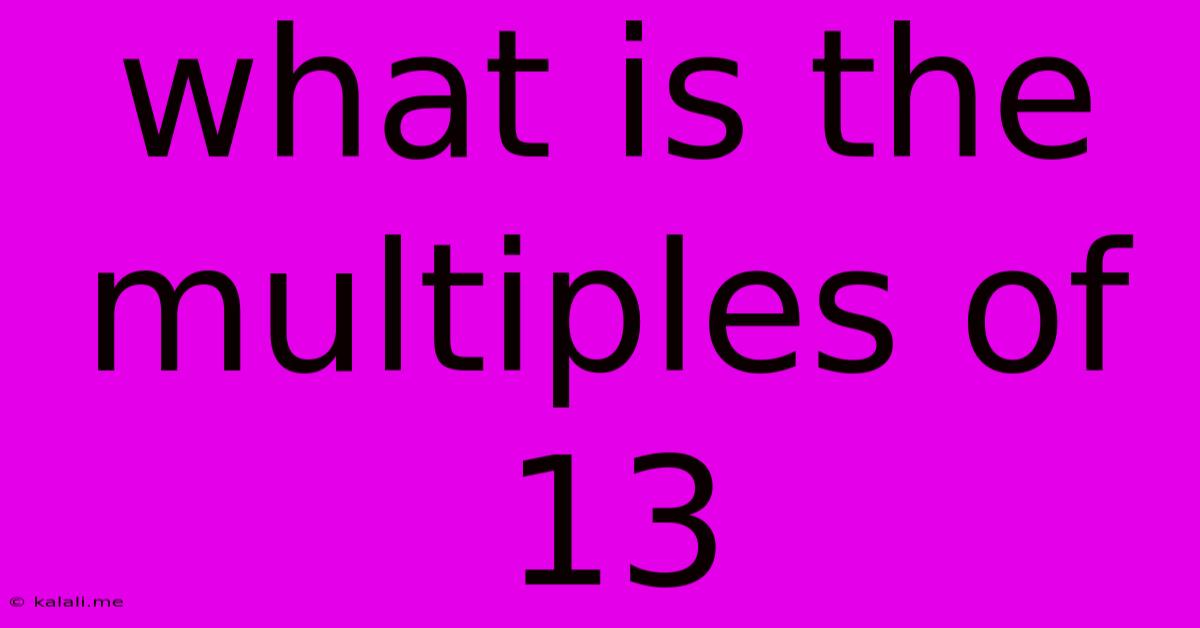What Is The Multiples Of 13
Kalali
Jun 13, 2025 · 2 min read

Table of Contents
What are the Multiples of 13? A Comprehensive Guide
Understanding multiples is fundamental in mathematics, and grasping the concept of multiples of 13 is crucial for various mathematical operations and problem-solving. This article provides a clear and comprehensive explanation of multiples of 13, exploring their properties and applications. Learn how to identify them, utilize them in calculations, and understand their significance in broader mathematical contexts.
What are Multiples?
Before delving into the multiples of 13 specifically, let's clarify the general concept of multiples. A multiple of a number is the product of that number and any integer (whole number). In simpler terms, it's the result of multiplying that number by 1, 2, 3, and so on. For instance, multiples of 5 include 5 (5 x 1), 10 (5 x 2), 15 (5 x 3), and so on.
Identifying Multiples of 13
The multiples of 13 are obtained by multiplying 13 by consecutive integers. The first few multiples of 13 are:
- 13 x 1 = 13
- 13 x 2 = 26
- 13 x 3 = 39
- 13 x 4 = 52
- 13 x 5 = 65
- 13 x 6 = 78
- 13 x 7 = 91
- 13 x 8 = 104
- 13 x 9 = 117
- 13 x 10 = 130
This sequence continues infinitely in both positive and negative directions. Therefore, the set of multiples of 13 is an infinite set.
Properties of Multiples of 13
- Divisibility: Any multiple of 13 is perfectly divisible by 13, leaving no remainder. This is the defining characteristic of a multiple.
- Pattern: While not as immediately obvious as some other numbers, multiples of 13 exhibit a pattern when examined closely. However, identifying this pattern isn't as straightforward as with multiples of 2 or 5.
- Arithmetic Sequence: The multiples of 13 form an arithmetic sequence with a common difference of 13. This means that the difference between any two consecutive multiples is always 13.
Applications of Multiples of 13
Understanding multiples of 13, like understanding multiples of any number, has applications in various areas, including:
- Number Theory: Multiples play a crucial role in number theory concepts like divisibility, prime factorization, and greatest common divisors.
- Algebra: Multiples are used extensively in algebraic expressions and equations.
- Real-World Problems: While less frequent than multiples of smaller numbers, situations might arise where knowing multiples of 13 is useful for solving practical problems involving quantities, measurements, or distributions. For example, calculating the total cost of 13 items priced identically.
Beyond the Basics: Finding Larger Multiples
To find larger multiples of 13, simply multiply 13 by the desired integer. For example, to find the 25th multiple of 13, calculate 13 x 25 = 325.
In conclusion, understanding multiples of 13, and multiples in general, provides a strong foundation for further mathematical exploration and problem-solving. While their immediate practical applications might seem less common than those of smaller numbers, their role in number theory and wider mathematical concepts remains significant.
Latest Posts
Latest Posts
-
What Are Two Elements That Are Liquid At Room Temperature
Jun 14, 2025
-
Gpa Requirements For Valdosta State University
Jun 14, 2025
-
At What Temperature Do Celsius And Fahrenheit Scales Coincide
Jun 14, 2025
-
What Is Difference Between Pound And Kg
Jun 14, 2025
-
Which Phase Of Mitosis Is The Longest
Jun 14, 2025
Related Post
Thank you for visiting our website which covers about What Is The Multiples Of 13 . We hope the information provided has been useful to you. Feel free to contact us if you have any questions or need further assistance. See you next time and don't miss to bookmark.